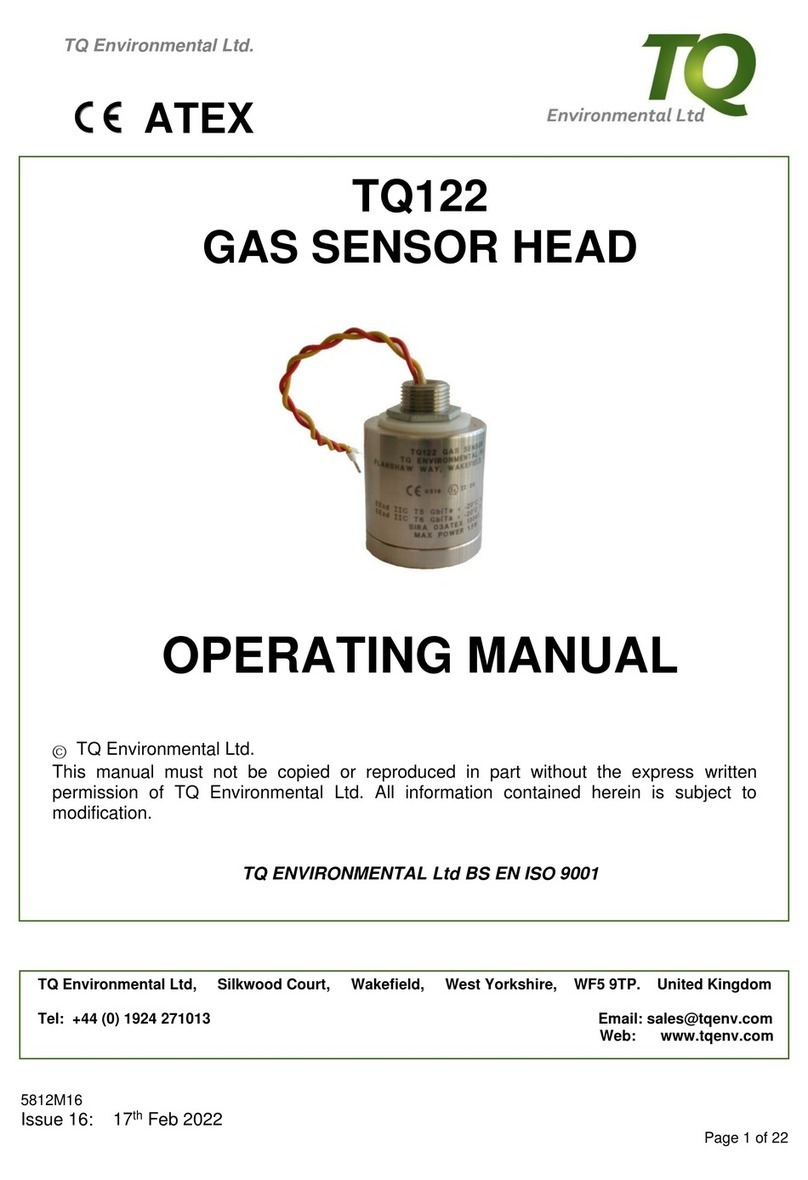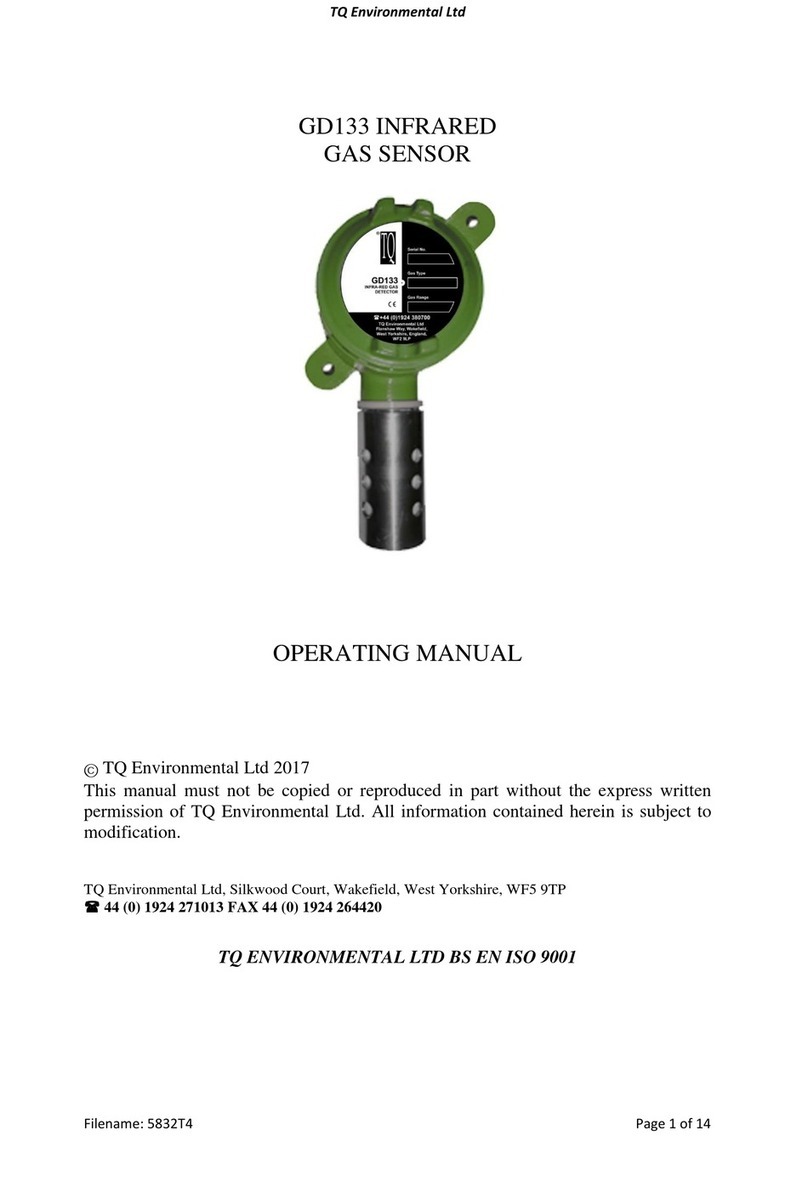TQ Environmental TQ131 User manual

INFRARED
REFRIGERANT GAS
SENSOR
OPERATING
MANUAL
TQ Environmental Limited
Silkwood Court
Wakefield
WF5 9TP
United Kingdom
Tel: +44 (0) 1924 271013
Fax: +44 (0) 1924 264420
Email: sales@tqenv.com
Web: www.tqenv.com
TQ131

Issue:8 March 2020 4951MMA8 Page 2 of 16
CONTENTS Page No
1 Description 5
1.1 General Description 5
1.2 Method of Detection 5
1.3 Sensor Unit Description 5
1.4 Gases Monitored 6
1.5 Models Covered by Manual 6
1.6 Performance Specification 7
2 Installation 8
2.1 Mechanical 8
2.1.1 General 8
2.1.2 Installation Guidelines 9
2.2 Electrical Installation 10
2.2.1 4 – 20 mA Version 10
2.2.2 Alarm Relay Version 10
3 Commissioning & Calibration 11
3.1 Commissioning 11
3.2 Calibration 11
3.3 Output Current Calculation 13
3.3.1 4 – 20 mA Version 13
4 Maintenance 14
4.1 Routine Maintenance 14
4.2 Warranty 14
5 Spares 14

Issue:8 March 2020 4951MMA8 page 3 of 16
PROPRIETARY
No part of the hardware or documentation may be reproduced, transmitted, transcribed, stored in a
retrieval system, or translated into any language or computer language, in any form or by any means,
without prior written permission of TQ Environmental Limited.
While great efforts have been made to assure the accuracy and clarity of this document,
TQ Environmental Limited assumes no liability resulting from any omissions in this document, or from
misuse of the information obtained herein. The information in this document has been carefully
checked and is believed to be entirely reliable with all of the necessary information included.
TQ Environmental Limited reserves the right to make changes to any products described herein to
improve reliability, function, or design, and reserves the right to revise this document and make
changes from time to time in content hereof with no obligation to notify any persons of revisions or
changes.
TQ Environmental Limited does not assume any liability arising out of the application or any use of
any product or circuit described herein; neither does it convey license under its patent rights or the
rights of others.
COPYRIGHT
© TQ Environmental Limited 2000-2015
This manual must not be copied or reproduced in part without the express written
permission of TQ Environmental Limited.
All information contained herein is subject to modification
WARNINGS, CAUTIONS AND NOTES
Warnings identify an operating or maintenance procedure, practice,
condition, or statement that, if not strictly followed, could result in death or injury to
personnel.
Cautions, which appear elsewhere in this manual, identify an operating or
maintenance procedure, practice, condition, or statement that if not strictly followed
could result in equipment damage or serious impairment of system operation.
Notes highlight certain operating or maintenance conditions or statements that are
essential but not of known hazardous nature as indicated by Warnings and Cautions.
Warnings, Cautions and Notes are included throughout this manual, as required.
Additionally, this section contains important Warnings that may not be contained
elsewhere within this instruction manual.

Issue:8 March 2020 4951MMA8 Page 4 of 16
SAFETY WARNINGS
THE GD131 FREON SENSOR MUST ONLY BE USED IN AREAS WHERE
POTENTIALLY FLAMMABLE GASES ARE NOT PRESENT.
FOR SAFETY REASONS, THE GD131 INFRA-RED GAS SENSOR MUST BE
INSTALLED, OPERATED AND SERVICED BY QUALIFIED PERSONNEL ONLY.
.
READ AND UNDERSTAND THIS INSTRUCTION MANUAL COMPLETELY
BEFORE OPERATING THE GD131 GAS SENSOR.

Issue:8 March 2020 4951MMA8 page 5 of 16
SECTION 1 - DESCRIPTION
1.1 GENERAL DESCRIPTION
The GD131 Infra-Red Sensor is a highly reliable infra-red (IR) absorption type sensor
designed to give extended service under extreme conditions. The sensor is used to detect
the presence of Refrigerant gases (R22, R134a, and similar gases). In a typical application,
the sensor unit is electrically connected to a system capable of either providing readouts
indicating the concentration of the gas detected by the sensor or generating alarms from
volt free alarm contacts changing over when a preset concentration of the refrigerant gas is
detected.
The GD131 Sensor is used for diffusion sensing applications. These are applications in
which the sensor continuously monitors that part of the environment with which it is in
contact and the gas diffuses through the sensor’s optical path. This technical manual covers
the use of the GD131 Sensor as a diffusion type sensor. As an alternative the sensor may
be equipped with “flow-through” measurement cell where an external pump is used to
introduce gas from a remote sensing point to the sensor as part of a sampling system.
1.2 METHOD OF DETECTION.
Detection of refrigerant gases is accomplished by measuring the absorption of IR energy
by the gas being monitored. This measurement is made over a fixed distance within a part
of the sensor assembly called the Optical Bench. A high intensity IR emitting lamp is
mounted, at one end of the optical bench. The lamp illuminates an IR detector at the
opposite end of the optical bench. The IR detector is designed to detect IR energy only
within a specific wavelength range at which adsorption of energy by the refrigerant gases
occurs. The introduction of the refrigerant gas into the optical path between the IR source
and the IR detector causes the detector output to reduce by an amount proportional the
refrigerant gas present. The IR source is switched between two levels at a 1.5-second rate,
and is controlled by a precision circuit which provides high-stability operation and reduces
thermal drift. Through several stages, this signal is amplified to a 4-20mA signal for remote
indication or to generate the concentration alarm.
1.3 SENSOR UNIT DESCRIPTION.
The fully assembled GD131 Sensor unit has the approximate, overall dimensions of
285mm (Height) X 154mm (Width) X 80mm (Depth). The main components of the GD131
Sensor unit are:
Junction Box (J-Box) with Amplifier
Optical Bench Assembly
Guard
Filter
Table of contents
Other TQ Environmental Accessories manuals




















